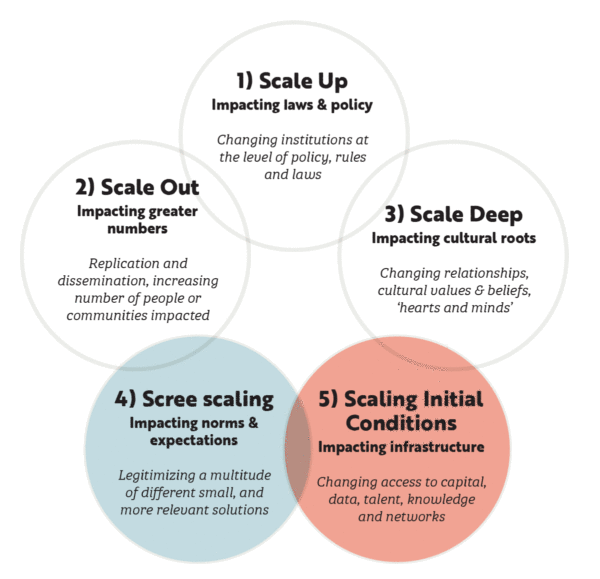What does it take to make a difference in community? ‘Spreading impact and knowledge’ may sound big or complicated. There’s no doubt this work can be hard. But look again at what you’re doing every day. Most likely, you’re already spreading impact and knowledge — because this is fundamental to creating change in communities.
Many of the stories that people have shared on this topic are about seeing – and creating – the opportunity. It’s an openness to connecting, to forming a new relationship. It’s an opportunity to invite someone in, to give someone a chance. It’s taking the chance to move this work beyond ourselves and engage others in making things happen. It’s supporting people to learn how to do something new so that they can help. It’s the willingness to share information and insight more broadly than usual. It’s planting seeds through people.
When we look again, we see that a new opportunity for even one person can make a big difference. Little ripples lead to bigger shifts. Sometimes the moment is right and a single event can reset how people think about others in their community. As opportunities emerge and grow, they can have an effect on the entire community.
The ideas and stories captured here were shared among members of the Regional Innovator’s Network (RIN) during a peer session on 5 June 2018.
Quick Summary
What does it mean?
- Spreading knowledge
- creating and spreading impact
What helps?
- Do the groundwork first and create the conditions
- Identify the spark and link the dots
- It is also about the small ideas
- Be intentional
- Share the knowledge
- Give someone a chance – and support them along the way
- Provide “scaffolding”
- Keep trying different things – don’t stop trying!
- Make it about the person, or the benefit to community
- Capture the impact
What does it mean?
Spreading knowledge
What kinds of knowledge and information are needed to do the work you’re doing? Who else might benefit from that information? Here are a few kinds of information and knowledge to consider sharing:
- Why? – why is this work needed? What are the social needs in your community (for particular populations, in particular places)? Are there any key insights you could share from your work in the community, innovation projects or in trying to create change?
- What? – what are you doing and how can people be a part of the work? What do they need to know in order to participate?
- How? – how will change come about? Consider sharing what you know about the innovation process.
- Who? – who is needed and how will you influence for change together?
Creating and spreading impact
What does impact mean in communities? There are a number of ways to create and spread impact. We have ideas of what we hope to achieve for community, and that’s the overall impact we’re hoping to create. But there are so many ways this work creates impact, and it often happens in ways we could not have imagined when we began.
Impact looks like:
- Making a surprising connection and developing relationships
- Giving someone a chance to try something new, develop a skill, or take on a role they never expected they could do — and supporting them to learn and be successful
- A taste of success…that then motivates someone to keep trying, keep building skills, and reframe what they see as possible for themselves
- Getting people working together — particularly when they’re not listening to one another or have stopped speaking with one another; helping people to work across boundaries, silos and scales
- Seeing others take initiative to support the work you’re doing – without you asking
- Changes happening in how people see one another, and what they expect from one another
- Achieving something in a community that was previously unthinkable
- A group or even a whole community seeing new possibilities for that place
All of the examples above are examples of creating impact – from one person at a time to groups and to the whole community.
Creating impact through scale
The following framework is another way of looking at creating impact: scale. This framework gives ideas of ways to scale. It can also be used to “measure” and track instances of impact.

Figure 1. Five forms of scaling, proposed by Gord Tulloch (adding two conceptions of scale to the framework proposed by Darcy Riddell and Michele-Lee Moore (2016). Source: https://inwithforward.com/2018/01/expanding-conceptions-scale-within-social-sector/
This model, proposed by Gord Tulloch, adds two forms of scaling to an original three proposed by Darcy Riddell and Michele-Lee Moore. The types of scale are:
- Scale up (impacting laws & policy) – changing institutions at the level of policy, rules and laws. An example of this is how the work that the Children and Prison Program (CAPP) group has developed in Dubbo has influenced council policy
- Scale out (impacting greater numbers) – replication and dissemination, increasing number of people or communities impacted. As an example of this is how the Down The Track program is being implemented across different communities in the region
- Scale deep (impacting cultural roots) – changing relationships, cultural values & beliefs, ‘hearts and minds’. As an example of this is are the initiatives that have taken place with Aboriginal people in Lake Cargelligo. Shane Phillips shares about the example in the following video:
- Scree scaling (impacting norms & expectations) – legitimising a multitude of different small, and more relevant solutions. As an example of this is how Growing Lachlan and the CAPP group are working with other organisations in the community. Check the Dubbo and Lachlan Shire case studies to explore this in detail.
Scaling initial conditions (impacting infrastructure) – changing access to capital, data, talent, knowledge and networks
Helpful hint: think about examples of each of these. Write a quick paragraph story about how impact was created. Make a habit of capturing these “instances of impact”.
What helps?
Do the groundwork first and create the conditions
Groundwork is required to understand the community issues, understand the context and frame the strategic pathways that you could follow. Before you even start spreading the impact you need to do all this groundwork first. You also need to create the right set of conditions to maximise the potential of spreading impact.
Identify the spark and link the dots
In conversations that you, identifying if there is a connection to other things happening in the community. Sometimes the connection will happen unexpectedly and identifying these can lead to joining forces to spread the impact.
“Picking up on people’s conversations, because sometimes people would say things and they are saying it and it’s picking up key things from there (…) It’s listening to that key conversation to identify those things, because sometimes is there where you can get the inspiration or the ideas from” Annette Ohlsen, Condobolin Community Connector
It is also about the small ideas
Spreading impact doesn’t need to be a big idea and you don’t need to spread ideas at a big scale. Small things can also be part of spreading impact.
“When I think about impact, I think it’s got to be massive, it needs to go right across the communities; or the capacity to go and model it and applying it somewhere else. And in the article you share it was a lot about small ideas. And I feel that that is where we spend most of our time, cultivating ideas and generating energy. Almost giving people the chance to run with it” Shane Phillips, Lake Cargelligo Community Connector
Be intentional
It is important to be intentional in every step we take in spreading impact and knowledge. Every action will lead to certain outcomes and being aware of those is paramount to spread the impact and knowledge.
“It’s about being very intentional in the conversations and in the relationships that we forge. It’s being intentional in the types of conversations that you host or facilitate in those meetings” Shane Phillips, Lake Cargelligo Community Connector
Share the knowledge
Part of spreading the impact is about sharing what you are doing, sharing resources and sharing information. If you take people along the journey, it will help them to process the learning and then take it back to their organisations.
“The CAPP is the collaboration of organisations that came together for the purpose stopping young people from going to the juvenile justice system. And it’s the first time that the young people are the focus like that, it’s the first time that Dubbo has something like that. And through all our learnings we looked at ways to make things better for the individual and do things differently for the community and the system. What people are learning and doing in CAPP they are taking it back to their organisations and changing things in their organisation” Sharon Tomas, Dubbo Community Connector
Give someone a chance – and support them along the way
Find ways to open up the work to others. Reach out and invite people in. Create opportunities where it seemed there were none. Open up possibility.
Identify people who can help. Who would you normally reach out to? Who would you normally share this information to? How might you go beyond the usual suspects?
“In Condobolin is a lit bit similar, they actually now have a whole week of NAIDOC stuff and at the end on the Saturday, it is a family fun day, the whole community comes together. I have sort of been involved with the guys this year. It’s been really great because there are some key young people that are involved, that are really taking this on and having ownership of it.” Annette Ohlsen, Condobolin Community Connector
Provide “scaffolding” – support people to be successful in a new opportunity. If someone tries something new, stay alongside them through the process so that they learn how to do it well. Take a gentle approach so that it feels doable and they are set up for success.
“From an example of a governance perspective, we’ve been involved in quite a few community meetings where there is no real governance or structure around how the meetings are progressing so we’ve brought it a secretariat aspect to it where we record what is happening in the meeting so that people can refer back to them and mentor someone into that secretariat role within the existing group to continue that knowledge” Rebecca Keeley, Executive Officer Lower Lachlan Community Services
Keep trying different things – don’t stop trying!
Encourage people to look at things – and each other – differently. If one strategy doesn’t work, try another. Don’t give up! Keep working to get that young person involved. Keep working to change behaviours that aren’t working. Keep working to influence the change that you believe in.
“Hope is so important. One of the first things when I started working in this, I had this great sense of hopelessness attached to people in the community. When there is a sense of hope, there is a sense of energy. So much comes with hope. I draw my hope from people that I am surrounded by here in Lake”. – Shane Phillips, Lake Cargelligo Community Connector
Make it about the person, or the benefit to community
Sometimes this work involves convincing people to do something they might not normally do. This is not always easy to do! One approach is to stay focused on the benefit to people, the goal that you all share. How will it help the individual? How will it help the community?
Capture the impact
In order to scale impact you need to be able to notice it and capture it. In your daily work find opportunities to take note of the impact that you observe and experience, this could be written down in stories which are called the “instances of impact”. This will be valuable to share what you are observing or experiencing with others
Frameworks and resources
- A blog about how scaling is not the linear innovation journey we think it is: https://www.thersa.org/discover/publications-and-articles/rsa-blogs/2017/07/why-we-need-to-rethink-how-innovation-scales?utm_medium=social&utm_source=twitter&utm_campaign=Jul-17-blogs&utm_content=blogs
- Gord Tulloch’s blog on 5 different types of scaling: https://inwithforward.com/2018/01/expanding-conceptions-scale-within-social-sector/
- Bonus reading: the original article on 3 types of scaling referred to in Gord’s blog developed my McConnel Family Foundation and Tamarack Institute in Canada: https://mcconnellfoundation.ca/wp-content/uploads/2017/08/ScalingOut_Nov27A_AV_BrandedBleed.pdf
Related capabilities
- Staying grounded and connected to community and place: Over and over again you keep coming back to why this work is needed. What is this community and place all about? How do you stay connected, how do you stay grounded?
- Maintaining energy and passion: When the going gets tough, what do you do?
- Thinking and acting strategically toward the broader goal: Impact over time comes from going back to that broader goal, over and over again. This capability provides frameworks to help get you there.



